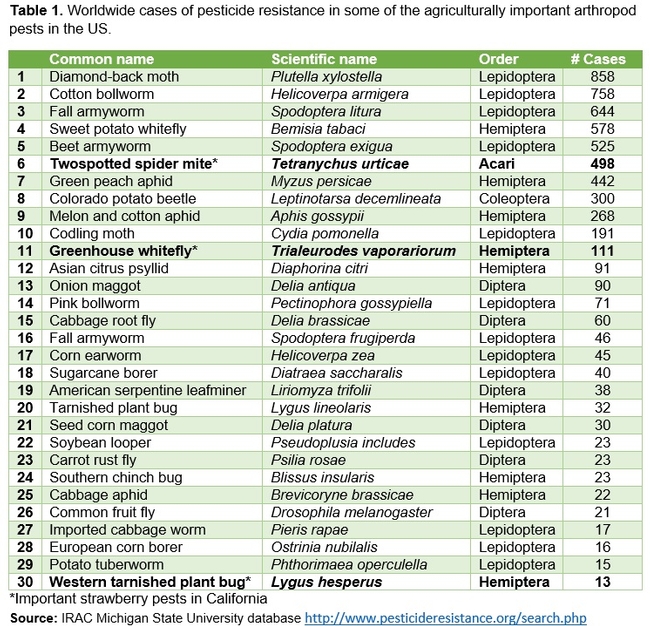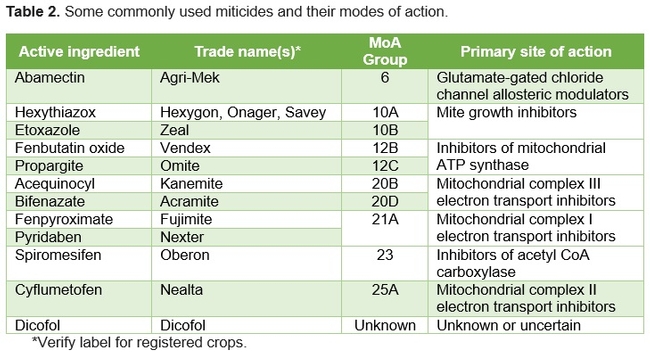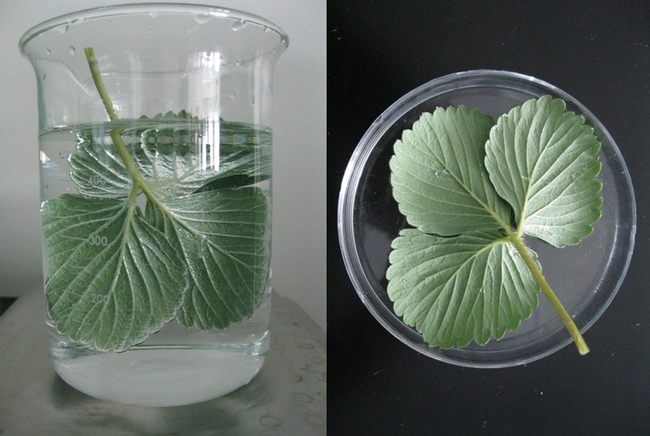Twospotted spider mite (TSSM) is a global pest infesting a wide variety of crops. TSSM adapts to new hosts very quickly compared to other arthropods and this ability is attributed to the groups or families of genes that detoxify poisonous plant compounds (Grbic et al., 2011). In just nine generations, TSSM was adapted to a resistant cucumber variety (Gould 1978) and this adaptation allowed them to use potato and tobacco as hosts (Gould, 1979) and imparted cross resistance to three organophosphate pesticides (Gould et al., 1982).
Genetic makeup of TSSM also helps to develop resistance to miticides and it has the highest incidence of resistance to pesticides among arthropods (Van Leeuwen et al., 2010; Grbic et al., 2011). Head and Savinelli (2008) reported that TSSM tops the list of arthropods with pesticide resistance by having resistance to 79 active ingredients in 325 cases based on the arthropod resistance database from Michigan State University by Whalon et al. (2006). However, in the current database, the number of resistance cases for TSSM went up to 498 (Table 1).
Multiple factors that contribute to the success of TSSM, rapid development of pesticide resistance, and the ability to feed on a large number of plant species include the following:
i) Short life cycle and high fecundity that lead to multiple generations in a short time.
ii) Haplo-diploid sex determination system, where males develop from unfertilized eggs and females from fertilized eggs. As a results unfavorable recessive alleles will be removed from mite populations.
iii) Spinning of a strong, but very thin webbing that provide protection against natural enemies
iv) Multiple families of detoxification genes that allow digestion, detoxification, and transportation of toxic metabolites.
v) Lateral transfer of genes from bacteria, fungi, and other organisms through lateral gene transfer which facilitated digestion and detoxification of xenobiotics.
vi) Large number (39) of multidrug resistance proteins compared to a smaller number (9-14) in vertebrates or invertebrates.
Since TSSM is a global pest on multiple hosts, the chances of exposure to pesticides is high, which creates a high selection pressure for resistance. Repeated use of effective pesticides renders them ineffective due to resistance development. Gould et al. (1991) reported slower adaptation of TSSM when a lower level of host plant resistance was combined with natural enemies rather than high host plant resistance alone. Monitoring resistance and adopting integrated pest management (IPM) practices is critical in managing TSSM.
General recommendations for managing TSSM:
- Regularly monitor several parts of the field for mite infestations and make appropriate treatment decision depending on the level and distribution of mite populations and environmental conditions.
- Consider an IPM approach by using biological control options (release of predatory mites), modifying cultural practices (avoiding water stress and excessive nitrogen fertilization), and applying botanical (rosemary oil or other similar products), microbial (BotaniGard, Pfr-97, Met 52, Grandevo, and Venerate), or chemical (Table 2) pesticides.
- Provide refuges that support susceptible mite populations to delay resistance development.
- When applying chemicalmiticides rotate those among different mode of action (MoA) groups. Use softer chemicals when predatory mites are used.
-
Periodically monitor miticide efficacy and signs of resistance development. If resistance is suspected, conduct a simple bioassay to confirm before field application of the miticide. Collect several leaves samples from different parts of the field with TSSM suspected to have resistance to a particular miticide. Prepare a small quantity of the spray liquid in a container following field application rates. Dip the leaves in the spray liquid and keep them in a covered container (not airtight) in a cool, dry place. Check 48 hours after the exposure to determine the efficacy of or resistance to the miticide based on TSSM mortality.
Bioassay to determine miticide resistance in twospotted spider mites.
Additional information on TSSM and its management in strawberries can be found at:
- Managing spider mites in California strawberries (//ucanr.edu/blogs/blogcore/postdetail.cfm?postnum=13943)
- Efficacy of botanical, chemical, and microbial pesticides on twospotted spider mites and their impact on predatory mites (//ucanr.edu/blogs/blogcore/postdetail.cfm?postnum=18553)
- Predatory mites for managing spider mites on strawberries (//ucanr.edu/blogs/blogcore/postdetail.cfm?postnum=14065)
- Response of predatory mites to chemical, botanical, and microbial miticides in strawberries (//ucanr.edu/blogs/blogcore/postdetail.cfm?postnum=14428)
- Spider mite damage causes unique foliar discoloration in Benicia variety (//ucanr.edu/blogs/blogcore/postdetail.cfm?postnum=11600)
- Multiple handouts on spider mites in strawberries (http://ucanr.edu/meetinghandouts)
- UC IPM Pest Management Guidelines for spider mites in strawberry (http://ipm.ucanr.edu/PMG/r734400111.html)
References
Gould, F. 1978. Predicting the future rresistance of crop varieties to pest populations: a case study of mites and cucumbers. Environ. Entomol. 7: 622-626.
Gould, F. 1979. Rapid host range evolution in a population of the phytophagous mite Tetranychus urticae Koch. Evolution 33: 791-802.
Gould, F. Carroll, C. R., and Futuyma, D. J. 1982. Cross-resistance to pesticides and plant defenses: a study of the two-spotted spider mite. Entomol. Exp. Appl. 31:175-180.
Grbic, M., Van Leeuwen, T., Clark, R.M., Rombauts, S., Rouzé, P., Grbic, V., Osborne, E.J., Dermauw, W., Ngoc, P.C.T., Ortego, F. and Hernández-Crespo, P. 2011. The genome of Tetranychus urticae reveals herbivorous pest adaptations. Nature, 479: 487-492. DOI: 10.1038/nature10640
Head, G. and C. Savinelli. 2008. Adapting insect resistance management programs to local needs. In: Onstad, D. W. (Ed.) Insect Resistance Management: Biology, Economics, and Prediction, Academic Press, United Kingdom, pp. 89-106.
Van Leeuwen, T., Vontas, J., Tsagkarakou, A., Dermauw, W. and Tirry, L. 2010. Acaricide resistance mechanisms in the two-spotted spider mite Tetranychus urticae and other important Acari: a review. Insect Biochem. Mol. Biol. 40: 563–572.
Whalon, M. E., Mota-Sanchez, D., Hollingworth, R. M., and Duynslager, L. 2006. Michigan State University Arthropod Resistance Database. http://www.pesticideresistance.org/search.php




